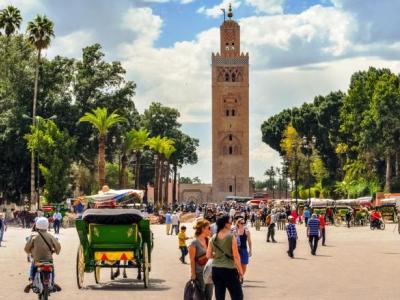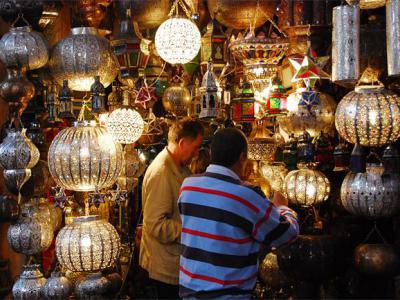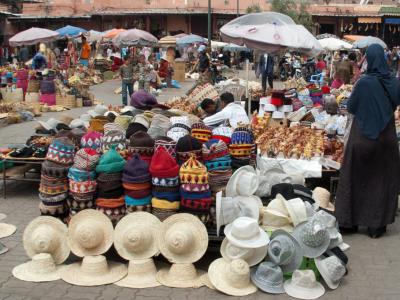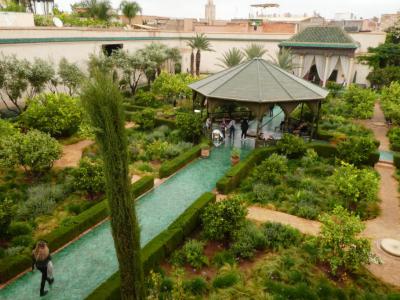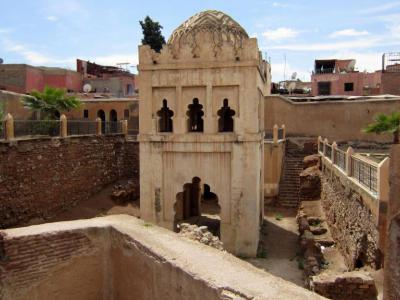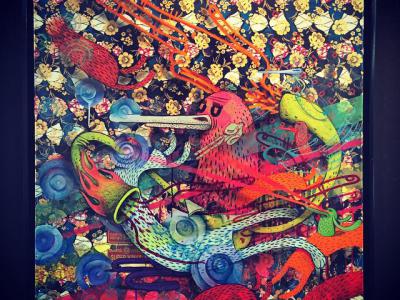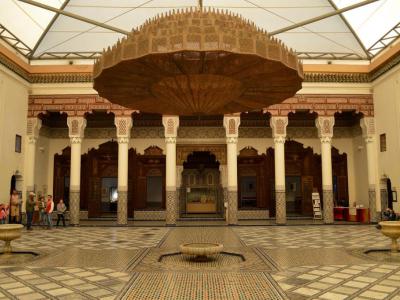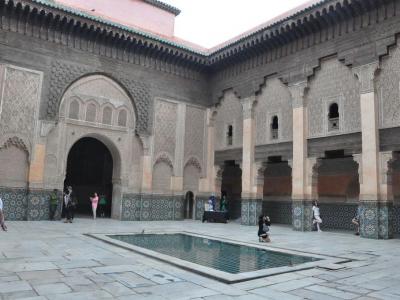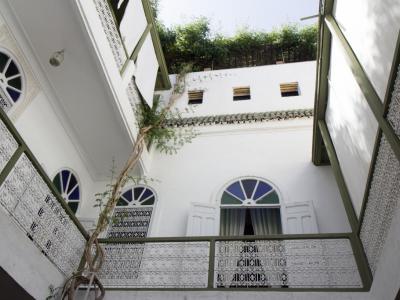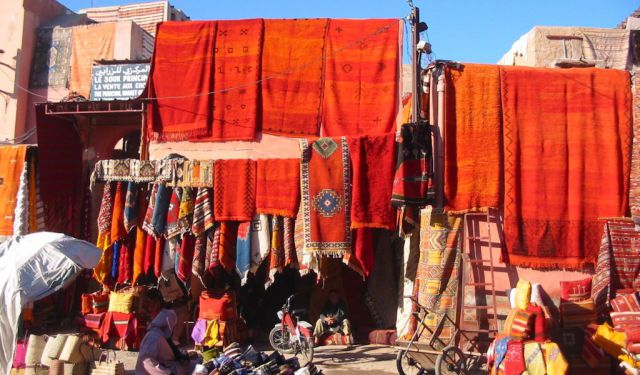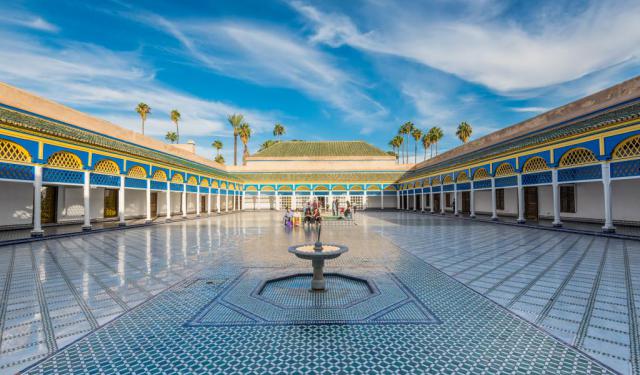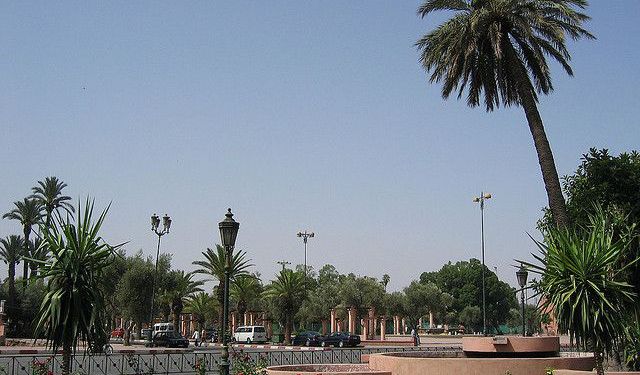
Medina Walking Tour (Self Guided), Marrakech
Marrakech Medina is a historic district dating back to the Middle Ages. Listed as a UNESCO World Heritage Site since 1985, this ancient walled city is a labyrinthine maze of narrow streets and bustling markets, known as souks, where you can immerse yourself in the local way of life.
One of the most iconic spots here is Jemaa el-Fnaa, a bustling square that comes alive with street performers, food stalls, and vendors selling a wide array of goods. It's a must-visit for anyone looking to experience the energy of Marrakech.
Semmarine Market (Souk Semmarine) is a busy marketplace where you can shop for traditional Moroccan crafts, textiles, spices, and more. This is an ideal place to pick up souvenirs and immerse yourself in the city's vibrant shopping scene.
Rahba Kedima Square is another charming spot in Medina, surrounded by shops and cafes. It's a great place to people-watch and soak in the atmosphere of Marrakech.
Marrakech Souks, or Marrakech Market, is a network of interconnected souks that offer a wide range of products, from leather goods to jewelry to ceramics. Exploring this location is a true sensory adventure.
Meanwhile, the Secret Garden (Le Jardin Secret) is an oasis of tranquility amidst the bustling Medina. It features beautifully landscaped gardens and traditional Moroccan architecture.
Further ahead, the Almoravid Koubba is an old Islamic monument that showcases the city's historical significance, while the neighboring Koubba Art Gallery (La Qoubba Galerie d'Art) and Marrakech Museum (Musee de Marrakech) are cultural institutions providing insight into the art and history of the region.
Practically next door to them, the Islamic college Ben Youssef Madrasa, with its intricate tilework and architecture, offers a glimpse into the city's educational heritage.
Finally, the House of Photography (Maison de la Photographie) is a unique museum that exhibits the history of photography in Morocco.
Medina unfolds its labyrinths right before your eyes. To fully appreciate the magic of this ancient district, consider taking this self-guided walk. Explore the narrow alleys, haggle in the markets, and immerse yourself in the unique culture of this city.
One of the most iconic spots here is Jemaa el-Fnaa, a bustling square that comes alive with street performers, food stalls, and vendors selling a wide array of goods. It's a must-visit for anyone looking to experience the energy of Marrakech.
Semmarine Market (Souk Semmarine) is a busy marketplace where you can shop for traditional Moroccan crafts, textiles, spices, and more. This is an ideal place to pick up souvenirs and immerse yourself in the city's vibrant shopping scene.
Rahba Kedima Square is another charming spot in Medina, surrounded by shops and cafes. It's a great place to people-watch and soak in the atmosphere of Marrakech.
Marrakech Souks, or Marrakech Market, is a network of interconnected souks that offer a wide range of products, from leather goods to jewelry to ceramics. Exploring this location is a true sensory adventure.
Meanwhile, the Secret Garden (Le Jardin Secret) is an oasis of tranquility amidst the bustling Medina. It features beautifully landscaped gardens and traditional Moroccan architecture.
Further ahead, the Almoravid Koubba is an old Islamic monument that showcases the city's historical significance, while the neighboring Koubba Art Gallery (La Qoubba Galerie d'Art) and Marrakech Museum (Musee de Marrakech) are cultural institutions providing insight into the art and history of the region.
Practically next door to them, the Islamic college Ben Youssef Madrasa, with its intricate tilework and architecture, offers a glimpse into the city's educational heritage.
Finally, the House of Photography (Maison de la Photographie) is a unique museum that exhibits the history of photography in Morocco.
Medina unfolds its labyrinths right before your eyes. To fully appreciate the magic of this ancient district, consider taking this self-guided walk. Explore the narrow alleys, haggle in the markets, and immerse yourself in the unique culture of this city.
How it works: Download the app "GPSmyCity: Walks in 1K+ Cities" from Apple App Store or Google Play Store to your mobile phone or tablet. The app turns your mobile device into a personal tour guide and its built-in GPS navigation functions guide you from one tour stop to next. The app works offline, so no data plan is needed when traveling abroad.
Medina Walking Tour Map
Guide Name: Medina Walking Tour
Guide Location: Morocco » Marrakech (See other walking tours in Marrakech)
Guide Type: Self-guided Walking Tour (Sightseeing)
# of Attractions: 10
Tour Duration: 1 Hour(s)
Travel Distance: 1.9 Km or 1.2 Miles
Author: ann
Sight(s) Featured in This Guide:
Guide Location: Morocco » Marrakech (See other walking tours in Marrakech)
Guide Type: Self-guided Walking Tour (Sightseeing)
# of Attractions: 10
Tour Duration: 1 Hour(s)
Travel Distance: 1.9 Km or 1.2 Miles
Author: ann
Sight(s) Featured in This Guide:
- Jemaa el-Fnaa
- Souk Semmarine (Semmarine Market)
- Rahba Kedima Square
- Marrakech Souks (Marrakech Market)
- Le Jardin Secret (The Secret Garden)
- Almoravid Koubba
- La Qoubba Galerie d'Art
- Musee de Marrakech (Marrakech Museum)
- Ben Youssef Madrasa
- Maison de la Photographie (House of Photography)
1) Jemaa el-Fnaa (must see)
Jemaa el-Fnaa is the busiest and most visited square in the medina quarter of Marrakech and is a lovely place to visit any time of day or night. This square has been a central marketplace, commercial area and meeting place since the city was founded in 1062. When the Almohades dynasty overthrew the Almoravides in 1147, much of Marrakech was destroyed, but this marketplace was quickly restored.
Nowadays, along the one side of the market you can see famous souks, while the other side is lined with hotels, gardens and terrace cafes. The ambiance here is always lively with lots of people and noise.
During the day you can easily quench your thirst buying fresh orange juice or water from the numerous sellers dressed up in traditional attire and bearing authentic leather water-skins and brass cups. Among the exotic attractions found in this market are Barbary Macaques performing tricks or sitting on your shoulder while you pose for a picture, as well as snake charmers and acrobats.
In the early evening, the juice sellers move on and their place is taken by the bands playing all sorts of music to which young Chleuh boys dance to amuse the public. Storytellers settle down to regale locals with their tales (sadly not in English), magicians practice their art and medicine men sell plant remedies.
At night, the music steps up a beat while food stalls are installed and the square becomes a huge open-air restaurant. The stalls are numbered, so once you have found the one you like, don’t forget to jot down its number for when you return to this lively square again.
Why You Should Visit:
Totally in line with expectations. The square is a meeting point and bursts with energy and trade vibes. Noisy and exotic.
Tips:
The many stalls selling traditional food here pose greater risk of food poisoning than the restaurants. Select a busy restaurant with many locals in it as a sign of good authentic fare to enjoy. The other option is to eat at one of the several rooftop restaurants surrounding the square: great view of the action but less confronting, though slightly more expensive.
Beware of pushy salespeople, "free offers", people with animals (e.g. monkeys, snakes), pickpockets, motorbikes, bicycles and carts. If you visit at night, don't shop – it's too busy to do much. Just walk around and enjoy the atmosphere. During the day (ideally in the morning, when it's cool) is the best time to shop and bargain (bargain hard!).
Consider hiring a guide. Expect to pay $40 for 3-4 hours (agree on the price before hiring) as the Jemaa is massive and it is very easy to get lost. Make sure you tell the guide what you want to see.
Nowadays, along the one side of the market you can see famous souks, while the other side is lined with hotels, gardens and terrace cafes. The ambiance here is always lively with lots of people and noise.
During the day you can easily quench your thirst buying fresh orange juice or water from the numerous sellers dressed up in traditional attire and bearing authentic leather water-skins and brass cups. Among the exotic attractions found in this market are Barbary Macaques performing tricks or sitting on your shoulder while you pose for a picture, as well as snake charmers and acrobats.
In the early evening, the juice sellers move on and their place is taken by the bands playing all sorts of music to which young Chleuh boys dance to amuse the public. Storytellers settle down to regale locals with their tales (sadly not in English), magicians practice their art and medicine men sell plant remedies.
At night, the music steps up a beat while food stalls are installed and the square becomes a huge open-air restaurant. The stalls are numbered, so once you have found the one you like, don’t forget to jot down its number for when you return to this lively square again.
Why You Should Visit:
Totally in line with expectations. The square is a meeting point and bursts with energy and trade vibes. Noisy and exotic.
Tips:
The many stalls selling traditional food here pose greater risk of food poisoning than the restaurants. Select a busy restaurant with many locals in it as a sign of good authentic fare to enjoy. The other option is to eat at one of the several rooftop restaurants surrounding the square: great view of the action but less confronting, though slightly more expensive.
Beware of pushy salespeople, "free offers", people with animals (e.g. monkeys, snakes), pickpockets, motorbikes, bicycles and carts. If you visit at night, don't shop – it's too busy to do much. Just walk around and enjoy the atmosphere. During the day (ideally in the morning, when it's cool) is the best time to shop and bargain (bargain hard!).
Consider hiring a guide. Expect to pay $40 for 3-4 hours (agree on the price before hiring) as the Jemaa is massive and it is very easy to get lost. Make sure you tell the guide what you want to see.
2) Souk Semmarine (Semmarine Market)
Located next to the city's main square, Jemaa al-Fnaa, the visually appealing Souk Semmarine is the largest market in the whole of Morocco, where traders have been selling goods for the past 1,000 years. If you're after colorful accessories such as authentic bags, shoes, or clothes, then this is the right place to wander around. The henna artists, hawkers and other locals trying to take advantage of tourists can get somewhat overwhelming, but that is all part of the experience.
Besides the colorful textiles and the fantastic smell of spices, another notable attraction inside Souk Semmarine are the shops selling lamps with intricate designs that really come to life when light is turned on in the evening. Lamp-making is a classic art in Morocco and the skill is passed down from one generation to the next. You will also find plenty of shops selling amazing selections of pottery, brass/metals, belts, and other genuine products; as a matter of fact, many of the goods sold here are manufactured onsite and have remained unchanged for centuries.
When shopping at Souk Semmarine, or anywhere in Morocco for that matter, you should haggle for a better price. While the concept of haggling may be strange for some Western visitors, it is actually a deep-rooted way of life for Moroccans. Shopping and haggling go hand in hand, so don't hesitate to secure a better deal. If the price is under 200DH, give half; if it is over 200DH, divide by 4. If they don't accept your offer, leave and go away – you'll find your stuff in another store.
Tip:
Stalls typically open between 9–10am and close around 7–8pm. In the middle of the day, temperatures can become a little too high for many, so the best times to visit are early morning / early evening. Also, be on your guard for scooters and avoid taking pictures of monkeys or snakes as their owners will 100% know that you have done it and will ask for money.
Besides the colorful textiles and the fantastic smell of spices, another notable attraction inside Souk Semmarine are the shops selling lamps with intricate designs that really come to life when light is turned on in the evening. Lamp-making is a classic art in Morocco and the skill is passed down from one generation to the next. You will also find plenty of shops selling amazing selections of pottery, brass/metals, belts, and other genuine products; as a matter of fact, many of the goods sold here are manufactured onsite and have remained unchanged for centuries.
When shopping at Souk Semmarine, or anywhere in Morocco for that matter, you should haggle for a better price. While the concept of haggling may be strange for some Western visitors, it is actually a deep-rooted way of life for Moroccans. Shopping and haggling go hand in hand, so don't hesitate to secure a better deal. If the price is under 200DH, give half; if it is over 200DH, divide by 4. If they don't accept your offer, leave and go away – you'll find your stuff in another store.
Tip:
Stalls typically open between 9–10am and close around 7–8pm. In the middle of the day, temperatures can become a little too high for many, so the best times to visit are early morning / early evening. Also, be on your guard for scooters and avoid taking pictures of monkeys or snakes as their owners will 100% know that you have done it and will ask for money.
3) Rahba Kedima Square
If you want to get the feeling of stepping back in time to early Marrakech, don't look further than the Rahba Kedima. This is one of the best market squares (though really more of a triangle) in the Medina district and is friendlier and more spacious than the souks, with ready-to-haggle vendors setting up their wares on the ground or on trestle tables. More traditional and more street-market-style than other, busier spots, it's also a great area to see basket weavers in action.
Aside from traditional hand-woven baskets, raffia bags, and colorful rugs, you will find a superb array of woolly hats, as well as all kinds of exotic herbs and spices. Some of the stands offer a mind-boggling range of goods: dried scorpions, leeches for medicinal purposes, snails (whose slime, you will be assured, does wonders against wrinkles) and other strange and sometimes rather repulsive objects used for witchcraft and black magic. Should you get tempted by low prices for chameleons and other reptiles, don't forget that taking such animals home with you is illegal due to quarantine laws.
When you've had enough shopping, have a mint tea in the famous Café des Epices, which also sells freshly made juices, sandwiches, salads and crepes. Watch the market work in the 'jardin' downstairs or enjoy the view from the terrace upstairs.
Why You Should Visit:
Like any bazaar, this market square has quite an impact and will keep you spellbound.
It's very easy to lose yourself in the array of Moroccan articles, spices and smells.
Tip:
Whatever original price you are offered, 1/4 it and that will be somewhere near the real cost.
Be aware of anyone giving you directions to or leading you up a backstreet, as it's more than likely you'll be mugged.
Aside from traditional hand-woven baskets, raffia bags, and colorful rugs, you will find a superb array of woolly hats, as well as all kinds of exotic herbs and spices. Some of the stands offer a mind-boggling range of goods: dried scorpions, leeches for medicinal purposes, snails (whose slime, you will be assured, does wonders against wrinkles) and other strange and sometimes rather repulsive objects used for witchcraft and black magic. Should you get tempted by low prices for chameleons and other reptiles, don't forget that taking such animals home with you is illegal due to quarantine laws.
When you've had enough shopping, have a mint tea in the famous Café des Epices, which also sells freshly made juices, sandwiches, salads and crepes. Watch the market work in the 'jardin' downstairs or enjoy the view from the terrace upstairs.
Why You Should Visit:
Like any bazaar, this market square has quite an impact and will keep you spellbound.
It's very easy to lose yourself in the array of Moroccan articles, spices and smells.
Tip:
Whatever original price you are offered, 1/4 it and that will be somewhere near the real cost.
Be aware of anyone giving you directions to or leading you up a backstreet, as it's more than likely you'll be mugged.
4) Marrakech Souks (Marrakech Market) (must see)
No visit to Morocco would be complete without spending hours in the Marrakech Souks, of which the best are to be found alongside Jemaa el-Fnaa. Most of these are, basically, historical sites and squares from centuries ago, now fitted with stalls and galleries where haggling is the name of the game, since nothing is priced and you'll be given a much higher price at the outset. Don't worry about offending the trader – he expects you to barter and would be disappointed if you didn't.
You'll find tons of shops selling everything that comes to mind, and the only problem is to decide what you can carry home as a souvenir. There are toy camels by the score, made of suede with leather bridles; you will see traditional costumes, bolts of material beyond counting, and leather goods – from belts and handbags to shoes and boots. There are ornately carved wooden boxes, jewelry, rugs and carpets, as well as traditional musical instruments, but if you aren't a good player, you can buy CDs instead. In some of the galleries, you can watch ironsmiths and tanners at work.
When you get thirsty you will, of course, find stalls selling fresh orange juice or some of the best mint tea in the city. The best part of these souks is the spice stands, where you will find every kind of exotic spice sold in jute bags to keep it fresh.
Why You Should Visit:
Loads of quality goods that you can get for practically nothing (if you can barter!) and if you like to be in the crowds and feel the vibes, just an amazing place to be.
Tip:
As there are about 11,000 shops to roam through, it is recommended to hire a guide who will show you the places to buy whatever you want and will get the best price for you. If visiting alone, walk purposefully, confidentially, and like you know where you're going. Step into a quiet place if you need to check directions, and when shop keepers call out to you, don't respond or be 'polite' by saying "no, thank you" – they are playing a competitive game, therefore a brief but non-attached smile is sufficient. Of course, it can be quite fun to engage, haggle and window shop if you feel like it, but that's up to you.
You'll find tons of shops selling everything that comes to mind, and the only problem is to decide what you can carry home as a souvenir. There are toy camels by the score, made of suede with leather bridles; you will see traditional costumes, bolts of material beyond counting, and leather goods – from belts and handbags to shoes and boots. There are ornately carved wooden boxes, jewelry, rugs and carpets, as well as traditional musical instruments, but if you aren't a good player, you can buy CDs instead. In some of the galleries, you can watch ironsmiths and tanners at work.
When you get thirsty you will, of course, find stalls selling fresh orange juice or some of the best mint tea in the city. The best part of these souks is the spice stands, where you will find every kind of exotic spice sold in jute bags to keep it fresh.
Why You Should Visit:
Loads of quality goods that you can get for practically nothing (if you can barter!) and if you like to be in the crowds and feel the vibes, just an amazing place to be.
Tip:
As there are about 11,000 shops to roam through, it is recommended to hire a guide who will show you the places to buy whatever you want and will get the best price for you. If visiting alone, walk purposefully, confidentially, and like you know where you're going. Step into a quiet place if you need to check directions, and when shop keepers call out to you, don't respond or be 'polite' by saying "no, thank you" – they are playing a competitive game, therefore a brief but non-attached smile is sufficient. Of course, it can be quite fun to engage, haggle and window shop if you feel like it, but that's up to you.
5) Le Jardin Secret (The Secret Garden) (must see)
Tucked away among the souks in the heart of the ancient Medina you will find this hidden gem – the perfect spot to have a nice leisurely lunch and getaway from all the hustle and bustle of Marrakech. In here, you will pretty much only hear birdsong, the water of the fountains, and, if lucky, the wind, while the magenta flowers are a feast for the eyes.
Following a careful restoration, the 'Secret Garden' – the 2nd-highest spot in the Medina after the Koutoubia minaret – is a beautiful spot to take photos over the city's rooftops, so be sure to take the option of going up the tower when at the admission counter. This way, you'll also be provided with a guide to assist your tour – well worth it given the information to be gained about, e.g., the amazing process of uncovering the ancient irrigation system supplying the gardens.
In one of the two gardens, there is a terrace cafe offering snacks and great juice blends / non-alcohol cocktails, while the other garden has various spots with benches to have a rest, read a book, or just enjoy the sublime Moroccan-style details.
Following a careful restoration, the 'Secret Garden' – the 2nd-highest spot in the Medina after the Koutoubia minaret – is a beautiful spot to take photos over the city's rooftops, so be sure to take the option of going up the tower when at the admission counter. This way, you'll also be provided with a guide to assist your tour – well worth it given the information to be gained about, e.g., the amazing process of uncovering the ancient irrigation system supplying the gardens.
In one of the two gardens, there is a terrace cafe offering snacks and great juice blends / non-alcohol cocktails, while the other garden has various spots with benches to have a rest, read a book, or just enjoy the sublime Moroccan-style details.
6) Almoravid Koubba
Since there aren't many buildings that survived the centuries in good condition, visiting the Koubba will be a real treat for amateur archaeologists. The sole surviving Almoravid building intact in Morocco, it was built in the 12th century and had been renovated/rebuilt in the 16th, before being buried under an outbuilding attached to the Ben Youssef Mosque.
Like so many cities, today's Marrakech is much higher than it once was, due to the custom of importing earth to cover the rubble of destroyed or pulled-down structures. The Koubba remained hidden until excavation work around the mosque began in 1948, and you can now reach it down a flight of steps.
Embodying all the decorative motifs which linger in any Arabian Nights fantasy, the small building has a ribbed dome and windows cut into ornate shapes – a variation on the classic North African (and Andalusian) style. Inside, it has motifs of acanthus leaves, palms, and pine cones, and there are subterranean chambers within the ruins running alongside.
There is quite a lot of calligraphy representing passages from the Quran; the foundation inscription, in particular, is the most ancient example of cursive Maghrebi script in North Africa. The Koubba was used for washing before prayer, and the inscription reads as "I was created for science and prayer, by the prince of the believers, descendant of the prophet, Abdallah, most glorious of all Caliphs. Pray for him when you enter the door, so that you may fulfill your highest hopes."
Like so many cities, today's Marrakech is much higher than it once was, due to the custom of importing earth to cover the rubble of destroyed or pulled-down structures. The Koubba remained hidden until excavation work around the mosque began in 1948, and you can now reach it down a flight of steps.
Embodying all the decorative motifs which linger in any Arabian Nights fantasy, the small building has a ribbed dome and windows cut into ornate shapes – a variation on the classic North African (and Andalusian) style. Inside, it has motifs of acanthus leaves, palms, and pine cones, and there are subterranean chambers within the ruins running alongside.
There is quite a lot of calligraphy representing passages from the Quran; the foundation inscription, in particular, is the most ancient example of cursive Maghrebi script in North Africa. The Koubba was used for washing before prayer, and the inscription reads as "I was created for science and prayer, by the prince of the believers, descendant of the prophet, Abdallah, most glorious of all Caliphs. Pray for him when you enter the door, so that you may fulfill your highest hopes."
7) La Qoubba Galerie d'Art
Experience the enchanting artistry of Morocco within the heart of Marrakech's Medina! Nestled within the historic Medina, close to the captivating cupola, lies the exquisite "La Qoubba Art Gallery," a space that harmoniously blends the charm of its location with the enchantment of diverse artists' creations. Conceived by Luciano Natali and Abdelatif El Karti, this gallery presents visitors with a splendid portrayal of Moroccan art in all its facets, offering an immersive journey into a realm of sensations and hues.
Whether you possess a fervor for artistic expression or harbor a curiosity for the allure of Moroccan creativity, La Qoubba Art Gallery beckons as an ideal destination. A cornucopia of artworks from across the nation and beyond awaits, each piece a testament to contemporary and semi-abstract styles—a refreshing departure from the monotony often encountered elsewhere.
Feel welcome to explore an array of price points and selections, ranging from original canvases and photographic masterpieces to artist-rendered prints and reproductions, all accompanied by certificates of authenticity. Here, there's no hard sell, no pressure to acquire; the space serves as a sanctuary for appreciation. Conveniently situated near the Marrakech Museum (Musée de Marrakech), the gallery's showroom awaits your visit.
Whether you possess a fervor for artistic expression or harbor a curiosity for the allure of Moroccan creativity, La Qoubba Art Gallery beckons as an ideal destination. A cornucopia of artworks from across the nation and beyond awaits, each piece a testament to contemporary and semi-abstract styles—a refreshing departure from the monotony often encountered elsewhere.
Feel welcome to explore an array of price points and selections, ranging from original canvases and photographic masterpieces to artist-rendered prints and reproductions, all accompanied by certificates of authenticity. Here, there's no hard sell, no pressure to acquire; the space serves as a sanctuary for appreciation. Conveniently situated near the Marrakech Museum (Musée de Marrakech), the gallery's showroom awaits your visit.
8) Musee de Marrakech (Marrakech Museum)
Housed in the 19th century Dar Menebhi Palace, which was beautifully restored in 1997 by the Omar Benjelloun Foundation, the Musée de Marrakech is worth visiting to see one of the best examples of Arab/Spanish architecture.
With its calming fountains, seating areas and detailed tile work, the central courtyard, which functions as the museum's atrium, was once open to the sky but now has been covered with glass. Its show-stopper is, undoubtedly, the huge hanging chandelier made of metal shards, each one delicately decorated with inscriptions and geometric symbols.
The side rooms around the courtyard have lovely painted wooden ceilings and house several pieces of interest, such as historical books and manuscripts, jewel-encrusted daggers and swords, clothes, coins, carpets and pottery from Arab, Berber and Jewish civilizations. The museum also holds temporary exhibitions on modern Moroccan art, but sadly, the explanations of each item, along with those in the permanent exhibition, are all in Arabic/French.
Why You Should Visit:
As long as you don't go inside expecting a historical museum experience, you will enjoy a stop here.
The interior courtyard is stunning with beautiful tiled floors, elegant arches and wonderful decoration.
Tip:
Don't miss the delightful courtyard café offering a shady peaceful spot to enjoy a mint tea and some 'gazelle horn' almond pastries. You don't have to enter the museum to drink/eat there, so it is worth going just for the refreshment.
With its calming fountains, seating areas and detailed tile work, the central courtyard, which functions as the museum's atrium, was once open to the sky but now has been covered with glass. Its show-stopper is, undoubtedly, the huge hanging chandelier made of metal shards, each one delicately decorated with inscriptions and geometric symbols.
The side rooms around the courtyard have lovely painted wooden ceilings and house several pieces of interest, such as historical books and manuscripts, jewel-encrusted daggers and swords, clothes, coins, carpets and pottery from Arab, Berber and Jewish civilizations. The museum also holds temporary exhibitions on modern Moroccan art, but sadly, the explanations of each item, along with those in the permanent exhibition, are all in Arabic/French.
Why You Should Visit:
As long as you don't go inside expecting a historical museum experience, you will enjoy a stop here.
The interior courtyard is stunning with beautiful tiled floors, elegant arches and wonderful decoration.
Tip:
Don't miss the delightful courtyard café offering a shady peaceful spot to enjoy a mint tea and some 'gazelle horn' almond pastries. You don't have to enter the museum to drink/eat there, so it is worth going just for the refreshment.
9) Ben Youssef Madrasa (must see)
You'll find the Ali Ben Youssef Madrasa in the Medina district of Marrakech and you shouldn't miss a trip to visit this important building, renovated and opened to the public in 1982. Founded in the 14th century and rebuilt in the 16th, during the Saadian Dynasty, the Madrasa was part of the complex of the nearby Almoravid mosque which was founded by Ali Ben Youssef during his reign between 1106-42, to which it was once attached.
Madrasa means "center of learning" and can be ascribed to a school, a college or a university; in this case, the building served as an Islamic college - one of the largest in North Africa, housing up to 900 students in very cramped conditions, as there were only 130 tiny bedrooms. These basic 'cubicles' barely had room to lay a sleeping mat or use an area for studying and for cooking – so take plenty of photos to show to kids the next time they moan about not having enough space!
Historical and academical significance aside, the madrasa draws in visitors who come to marvel at the large central courtyard beautifully decorated in carved cedar and marble with lovely stuccowork, drawing comparisons to the Alhambra in Granada, Spain. The tiles are laid out in geometrical patterns and bear inscriptions – mostly phrases from the Quran – as, of course, no human or animal representations are allowed. There is also a big pool in the middle that served for ablutions before entering the prayer room that backs onto the courtyard.
Tip:
Go early or late; avoid midday as it's too crowded to enjoy.
Madrasa means "center of learning" and can be ascribed to a school, a college or a university; in this case, the building served as an Islamic college - one of the largest in North Africa, housing up to 900 students in very cramped conditions, as there were only 130 tiny bedrooms. These basic 'cubicles' barely had room to lay a sleeping mat or use an area for studying and for cooking – so take plenty of photos to show to kids the next time they moan about not having enough space!
Historical and academical significance aside, the madrasa draws in visitors who come to marvel at the large central courtyard beautifully decorated in carved cedar and marble with lovely stuccowork, drawing comparisons to the Alhambra in Granada, Spain. The tiles are laid out in geometrical patterns and bear inscriptions – mostly phrases from the Quran – as, of course, no human or animal representations are allowed. There is also a big pool in the middle that served for ablutions before entering the prayer room that backs onto the courtyard.
Tip:
Go early or late; avoid midday as it's too crowded to enjoy.
10) Maison de la Photographie (House of Photography) (must see)
This charming museum, open since April 2009, does a splendid job of documenting the history of Marrakech and Morocco from 1870 to 1950 in photographs. It's a former inn (funduq) that has been beautifully renovated and consists of three floors of over 4,500 old photos as well as slides and documents, all of which change every six months.
Though portraits are given prominence, the collection includes some of the country's unusual aspects, through pictures of the archaeological site of Volubilis, Moroccan landscapes, as well as important architectural complexes and casbah. Historical and cultural aspects such as Berber culture are not only portrayed in photographs, but also in the first color movie documentary filmed by Daniel Chicault in 1957 on the Berber tribes of the High Atlas.
A café on the rooftop terrace is ideal for refreshments with great city and mountain views after perusing the photographs.
Though portraits are given prominence, the collection includes some of the country's unusual aspects, through pictures of the archaeological site of Volubilis, Moroccan landscapes, as well as important architectural complexes and casbah. Historical and cultural aspects such as Berber culture are not only portrayed in photographs, but also in the first color movie documentary filmed by Daniel Chicault in 1957 on the Berber tribes of the High Atlas.
A café on the rooftop terrace is ideal for refreshments with great city and mountain views after perusing the photographs.
Walking Tours in Marrakech, Morocco
Create Your Own Walk in Marrakech
Creating your own self-guided walk in Marrakech is easy and fun. Choose the city attractions that you want to see and a walk route map will be created just for you. You can even set your hotel as the start point of the walk.
Marrakech Shopping Tour
Shopping in Marrakech is an extraordinary experience that captivates the senses. Perhaps no other shopping in your life will compare to it: vivid, bright, juicy colors of carpets, clothes, and shoes; enchanting smells of local perfumes and spices; crafts, handmade jewelry, pottery; and of course, the long shopping mazes and souks.
One of the most iconic shopping destinations in Marrakech is... view more
Tour Duration: 1 Hour(s)
Travel Distance: 1.0 Km or 0.6 Miles
One of the most iconic shopping destinations in Marrakech is... view more
Tour Duration: 1 Hour(s)
Travel Distance: 1.0 Km or 0.6 Miles
Marrakech Introduction Walking Tour
The fourth largest city in Morocco, Marrakech is a true out-of-the-ordinary getaway combining old historic atmosphere with a lively sights of today. The medina quarter of Marrakech – a UNESCO World Heritage Site – comprises a medieval walled city, dating back hundreds of years to the days of Berber Empire, whose mazelike alleys are still densely packed with vendors and stalls luring buyers... view more
Tour Duration: 2 Hour(s)
Travel Distance: 3.9 Km or 2.4 Miles
Tour Duration: 2 Hour(s)
Travel Distance: 3.9 Km or 2.4 Miles
Moroccan Palaces Walking Tour
One of the meaningful ways to pass the time away in Marrakech is to visit the local palaces. This is particularly true given that some of them, now restored and refurbished, function as museums. Others, on the other hand, are slowly turning into ruins, which is sad. Nonetheless, they all have a long story to tell and spectacular architecture fit to amaze any beholder.
Among the most renowned... view more
Tour Duration: 1 Hour(s)
Travel Distance: 2.7 Km or 1.7 Miles
Among the most renowned... view more
Tour Duration: 1 Hour(s)
Travel Distance: 2.7 Km or 1.7 Miles
Marrakech Top Religious Sites
Islam is the official religion in Morocco, which is why it is only natural that mosques are the dominant religious sites in the country, and Marrakech is no exception. Outside these places of worship, the city's religious scene is represented by unique historical monuments (koubbas), cemeteries, and mausoleums – all quite interesting to explore.
Our journey starts with the Ben Youssef... view more
Tour Duration: 1 Hour(s)
Travel Distance: 2.7 Km or 1.7 Miles
Our journey starts with the Ben Youssef... view more
Tour Duration: 1 Hour(s)
Travel Distance: 2.7 Km or 1.7 Miles
Moroccan Architecture Walking Tour
No tall skyscrapers, no sophisticated giant malls, no anything else of Western architecture await you on this tour. Our self-guided walk is entirely about the genuine Moroccan style. We are going to reveal Marrakech which will amaze you with its majestic structures, traditional motifs, and mystic atmosphere.
Our first stop is a prominent example of Islamic architecture, the Koutoubia Mosque.... view more
Tour Duration: 3 Hour(s)
Travel Distance: 4.6 Km or 2.9 Miles
Our first stop is a prominent example of Islamic architecture, the Koutoubia Mosque.... view more
Tour Duration: 3 Hour(s)
Travel Distance: 4.6 Km or 2.9 Miles
Gueliz Walking Tour
Gueliz, also known as the New City (Nouvelle Ville), is more like the downtown of Marrakech. Here you will definitely feel the Western influence: McDonald's, KFC, brand stores, and even a supermarket. Still, Gueliz is also famous for its art galleries and parks.
We'll start our acquaintance with Gueliz in the El-Harti Gardens (Jnane El Harti), a peaceful oasis amidst the bustling... view more
Tour Duration: 2 Hour(s)
Travel Distance: 3.1 Km or 1.9 Miles
We'll start our acquaintance with Gueliz in the El-Harti Gardens (Jnane El Harti), a peaceful oasis amidst the bustling... view more
Tour Duration: 2 Hour(s)
Travel Distance: 3.1 Km or 1.9 Miles
The Most Popular Cities
/ view all
